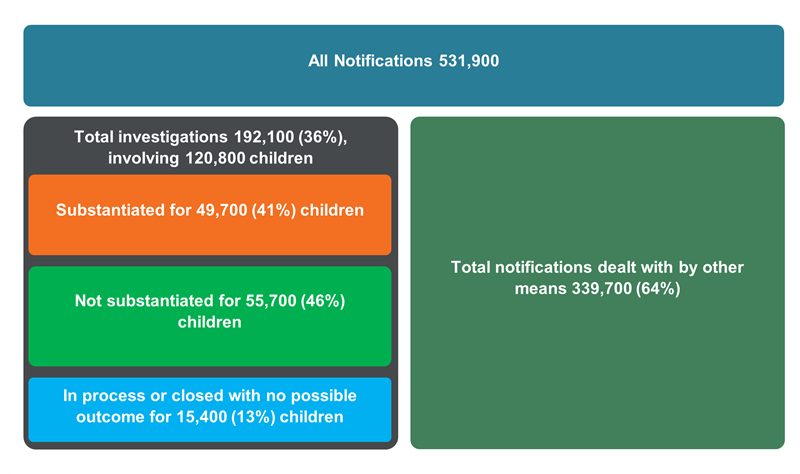Notifications, investigations and substantiations
Key findings
- 192,100 investigations of notified abuse/neglect were conducted for 120,800 children in 2020–21.
- 72,900 notifications of child maltreatment were substantiated for 49,700 children in 2020–21.
- 14,600 (43 per 1,000) Indigenous children were the subjects of substantiations.
How is child maltreatment determined?
Notifications, investigations and substantiations are the entry point for children into the child protection system. These components are sequential, with an initial notification of child maltreatment made to a child protection department, followed by an investigation of the alleged maltreatment (if required), and concluding with a substantiation decision (Figure 3.1).
Figure 3.1: Overview of notifications, investigations and substantiations, 2020–21

Chart: AIHW.
Sources: Supplementary data tables S3.1 and S3.3, AIHW Child Protection Collection 2020–21.
The data in this section relate to notifications that departments responsible for child protection received between 1 July 2020 and 30 June 2021 (see Table 3.1 and Appendix A for further information).
| Component of the system | What is involved? | When does this take place? |
|---|---|---|
| Notification | A notification is a report made to a child protection department alleging child abuse/neglect, child maltreatment or harm to a child. These reports can be made by individuals or organisations. | Notifications are usually the entry point for children into the system. The notification triggers an intake process where child protection workers evaluate the report and determine what action to take. The threshold for recording a notification differs in each jurisdiction (see Appendix A). |
| Investigation | The process by which departments gather more information about a child involved in a notification. Staff assess the harm or degree of harm to a child, and their protective needs. Investigations also include sighting or interviewing the child where practical. | An investigation is undertaken when a notification of alleged abuse meets the threshold for further action. This threshold differs in each jurisdiction (see Appendix A). |
| Substantiation | A substantiation is the result of a finalised investigation which concludes that there is reasonable cause to believe that a child has been, is being, or is likely to be, abused, neglected or otherwise harmed. This may also include cases where children have no suitable caregiver. | A substantiation decision is part of finalising an investigation. The notification will either be 'substantiated' or 'not substantiated'. A notification will be substantiated only if it meets a threshold of harm. This threshold differs in each jurisdiction (see Appendix A). |
Box 3.1 outlines data limitations for reporting on children who are the subjects of notifications, investigations and substantiations.
Box 3.1: Data limitations for children who are the subjects of notifications, investigations and substantiations
Although specifications for notifications, investigations and substantiations have been agreed for national reporting, there are differences in jurisdictional legislation, policy and practice which influence the reported data. Notification counts are not comparable across jurisdictions and differences in the initial count of notifications have a flow-on effect on other data, including the number of investigations, substantiations, and substantiations per child. Refer to the Technical notes and Appendixes A to C before comparing across jurisdictions.
Some notable issues which affect the completeness and interpretability of the data presented in this section include:
- In 2017–18, New South Wales was unable to provide data on substantiations due to the implementation of a new client management system. Therefore, substantiations data for 2017–18 excludes New South Wales.
- From 2017–18, New South Wales changed the way investigations of notifications are counted to include only field assessments. This results in lower counts of investigations from 2017–18 onwards for New South Wales.
- In July 2018, the Northern Territory introduced the One Child One Case policy which has meant that a new investigation may not be required for subsequent notifications if a child has a current open case. Consequently, fewer investigations were commenced effective from 2018–19 when compared with previous periods.
- Analysis by co-occurrence of abuse, remoteness and socioeconomic area should be interpreted with caution as the data items are not always complete.


